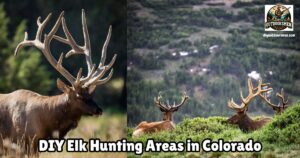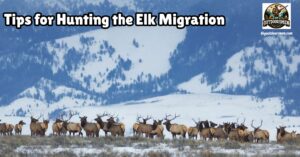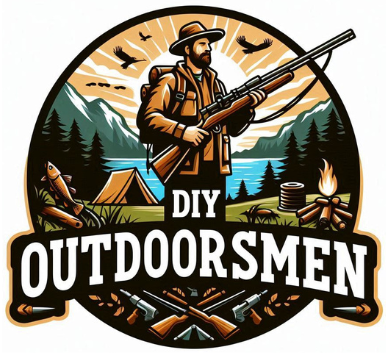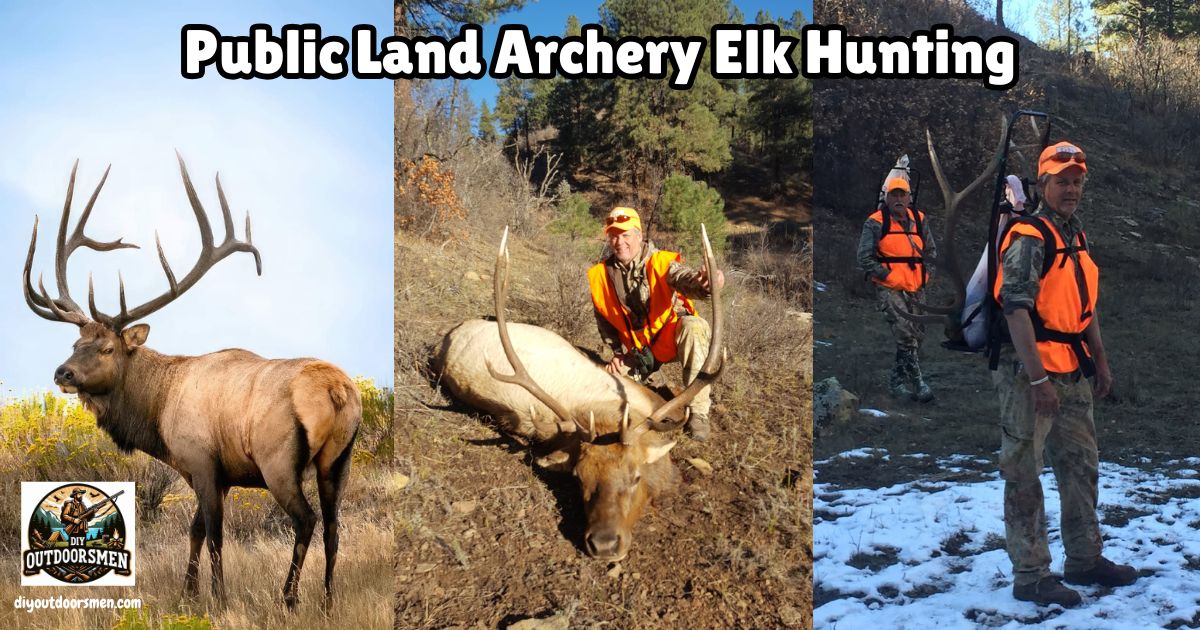Contents
- 1 Core Gear and Preparation for Public Land Archery Elk Hunts
- 2 Scouting: Before the Hunt Even Begins
- 3 Going Further Outworking Pressure and Finding Elk
- 4 Understanding Elk Patterns and Behavior in Public Land Hunts
- 5 Calling Strategies and Getting the Right Reaction
- 6 Staying Safe and Ready for the Unexpected
- 7 Common Challenges and How I Handle Them
- 8 Frequently Asked Questions
- 9 Final Thoughts on Public Land Archery Elk Hunting
Public land archery elk hunting draws thousands of hunters looking for adventure and the chance to harvest a mature bull. For me, the challenge comes from chasing an elusive animal on ground that’s open to everyone.
QUICK LOOK: Common Challenges of Public Land Elk Hunting
- Hunter Competition: Getting away from crowded access points, heading deeper into the backcountry, or starting hunts earlier and staying out later improves my odds at finding elk that haven’t been pressured.
- Weather: I always keep an eye on forecasts and pack for sudden storms. Elk may switch up patterns in rain or snow, but sticking it out through rough weather sometimes lets me track down elk on the move while others call it a day.
- Fatigue: Good food, hydration, and pacing my hunt let me stay sharp for that split second when a shot presents itself. I make sure to rest, eat up, and stretch between big pushes.
- Shot Opportunities: Archery shots on elk are rarely easy. Staying calm, practicing real-world shooting distances ahead of time, and being patient have been the keys for me in connecting when it matters most.
Competition from other hunters, unpredictable weather, and the wily nature of elk all combine to create a unique test. I’m sharing what I’ve learned through years of trial, error, and a lot of hiking, so you can improve your odds next season.
Core Gear and Preparation for Public Land Archery Elk Hunts
Hunting elk with a bow on public land calls for much more than just strong archery skills. I always start with solid planning and dependable gear. Archery elk areas are often remote, so having the right essentials helps keep me safe, comfortable, and ready for anything.
When choosing gear, my list starts with a reliable compound or recurve bow that I’ve practiced with all year. I carry a sturdy backpack, waterproof clothing that layers well, lightweight boots with solid traction, and high-quality binoculars.
A GPS or offline mapping app on my phone, a headlamp, extra food, water purification tablets, and a first aid kit always go in my pack. I also bring broadheads I’ve field tested, a rangefinder that works in low light, and elk calls suited to various situations.
Scouting can be just as essential as equipment. I find topographic maps, aerial imagery from Google Earth, and hunting-specific apps like onX Hunt super helpful. Scouting before the season gives me a sense of likely elk hangouts, helps identify water sources, bedding cover, and possible pressure points.
If I can’t make it out in person, I still do plenty of online mapping. Talking to local rangers, wildlife officers, or other hunters gives me more context for what to expect when I hit the woods. Physical preparation can’t be overlooked, either.
Rugged terrain means I’ve got to be in decent shape. I try to maintain a fitness routine through the off-season, adding hikes with a loaded backpack, cardio workouts for endurance, and regular range sessions to keep my shooting accurate no matter how tired I am by the time a bull steps out.
Scouting: Before the Hunt Even Begins
E-scouting has become a daily part of how I get ready for archery elk season. Tools like Google Earth and onX Hunt let me check out elevation, tree cover, and water availability from my computer well before I set foot in the area.
- Security Cover: Elk favor secluded places like dark timber, north-facing slopes, and benches away from main trails. I spot these on satellite images and compare them with previous elk sign found in person.
- Food and Water: Tracking down open meadows, old burn areas rich in new growth, streams, wallows, and springs is critical. Elk rely on easy access to both food and water throughout the season.
- Travel Corridors: Saddles, ridgelines, and pinch points direct elk movement, especially between bedding and feeding areas. Recognizing these helps me pick stand locations or ambush points.
If I can scout in person, I look for fresh sign like droppings, beds, rubs, tracks, and trails. Early mornings and evenings are the best for this kind of ground work, as elk are often active around the edges of clearings or timber.
Another solid approach is to ask around. Forums, social media groups, and conservation officers share great insight into elk trends, recent habitat changes, or any new hunter access restrictions. Local knowledge has guided me away from crowded trailheads and toward empty drainages more than a few times.
Sometimes I make a game plan to mark multiple backup locations before the hunt. Knowing several valid parking spots or less obvious trailheads can be priceless if I arrive and find the main lot jammed with trucks. Having options keeps my hunt rolling, no matter how many folks show up on opening morning.
Going Further Outworking Pressure and Finding Elk
One of the biggest challenges of public land archery elk hunting is managing pressure from other hunters. I’ve learned that elk will slip into remote areas and use tough terrain features to avoid humans once the season starts. That’s why I often hike well away from roads, motorized trails, and popular access points.
Sometimes I’ll camp for several days away from the truck, reducing daily travel and boosting my chances of finding undisturbed elk. Elk stick to routines but adjust fast to hunting pressure. If I run into boot tracks or hear constant bugles from other hunters, I head for new drainages or climb into higher, rougher ground.
Persistence counts, and not spotting elk at first doesn’t mean they aren’t around. Covering a lot of ground—sometimes five or more miles a day—keeps me on fresh sign. Long midday sits near hard-to-reach wallows or crossing points have paid off for me more than once, especially when hunting pressure pushes elk out of open areas.
I focus on blending in, sitting still when the wind covers my approach, and keeping my scent and movement to an absolute minimum. Staying flexible, even within a single day, can make a huge difference.
If I glass a drainage and see hunters moving in, I don’t hesitate to mix it up and try a secondary area or approach from a different angle. The elk do it—so should you. Sometimes the difference between seeing animals and just covering ground comes down to your willingness to adapt and outpace the pressure.
Understanding Elk Patterns and Behavior in Public Land Hunts
Elk behavior shifts with the season and with how much of pressure hunters put on them. During the early archery season, elk may be more visible in open parks and meadows at dawn and dusk. As the rut picks up, bulls tail cow groups, and bugling cranks up. Knowing the timing of the rut in the area I’m hunting helps me plan when to use calls or focus on spot and stalk tactics.
During peak pressure or after the first few days, elk often retreat into thicker cover or sneak into overlooked corners of the unit. I find that focusing on fresh sign—tracks, droppings, beds—works better than sticking to spots where I saw elk during preseason scouting.
Wind is always a crucial factor in archery elk hunting. Elk smell better than any other big game I’ve hunted. I constantly keep an eye on the wind direction with a powder bottle, try to keep my clothing as scent-free as possible, and use thermals to approach bedding spots either early or late in the day. If I spook elk because they catch my scent, I mark the location and work out a new plan for the next attempt.
Calling Strategies and Getting the Right Reaction
Calling elk with a bow is easily one of the most thrilling aspects of the hunt, but it’s also easy to overdo, especially on pressured ground. Bulls, especially older ones, have likely heard lots of bugles and cow calls before I even set up. I try to listen first and call only when my position is downwind and I’m close enough for a bull to care.
- Start Subtle: I usually open with soft cow calls and chirps. This lets me check interest without scaring animals if I’m too close.
- Timing Matters: If the rut is going, a strategic bugle or sharp cow call could draw a fired-up bull. During quieter phases, I go subtle or stay silent.
- Call Less Under Pressure: If calls are ignored or elk seem shy, I focus on moving quietly, shadowing travel corridors or following fresh sign, rather than talking elk into range.
Sometimes, saying nothing and just intercepting elk as they naturally travel proves more successful. I always judge day by day based on how elk act.
Staying Safe and Ready for the Unexpected
Public land can be wild and change in a flash. I make sure someone knows my location and expected routes before I head out. Carrying an emergency GPS locator or satellite messenger is something I always do, especially when going solo. In mountain country, sudden weather can split the sky with storms, so a rain jacket, warm layers, and fire-starting tools go in my pack.
Physical fitness is a serious asset. Archery Elk hunting almost always means slogging up and down steep country, dragging a heavy pack. I work on my legs before the season, throw in some cardio, and take practice hikes with weight to mimic real conditions. Going at my own pace means fewer mistakes and keeps me in the game after grueling days on the mountain.
Giving myself several days or more for an elk hunt lets me adjust strategies if conditions change. Even if elk move or pressure ramps up, having extra time builds my odds of stumbling upon that perfect opportunity.
Common Challenges and How I Handle Them
- Hunter Competition: Getting away from crowded access points, heading deeper into the backcountry, or starting hunts earlier and staying out later improves my odds at finding elk that haven’t been pressured.
- Weather: I always keep an eye on forecasts and pack for sudden storms. Elk may switch up patterns in rain or snow, but sticking it out through rough weather sometimes lets me track down elk on the move while others call it a day.
- Fatigue: Good food, hydration, and pacing my hunt let me stay sharp for that split second when a shot presents itself. I make sure to rest, eat up, and stretch between big pushes.
- Shot Opportunities: Archery shots on elk are rarely easy. Staying calm, practicing real-world shooting distances ahead of time, and being patient have been the keys for me in connecting when it matters most.
Frequently Asked Questions
What’s the best way to scout new public land for archery elk?
I rely on a mix of online mapping—like Google Earth and onX Hunt—and on-the-ground trips looking for food, water, cover, and elk sign. Asking locals and other hunters adds valuable context.
Are bugling and cow calls always necessary for elk hunting?
Not always. While rutting bulls may respond to calls, public land elk can get call-shy with heavy pressure. Sometimes, staying quiet and tracking fresh sign into travel corridors works better.
How do I deal with overcrowded hunting areas?
I move farther from roads and trails, look for overlooked chunks of cover, and hunt during off-peak hours. Flexibility and a willingness to check out new areas help me avoid pressure.
How do I consistently find elk during the season?
Persistence is key. I cover ground, tune in to current sign, and switch up my daily strategies as elk adjust. Adapting to their shifting patterns and sticking with it are two big keys I lean on.
Final Thoughts on Public Land Archery Elk Hunting
Taking on a public land archery elk hunt demands patience, adaptability, and a will to dig deep, sometimes to your limits. Every trip I’ve taken has taught me something new, and I’ve found that being prepared, paying attention to the landscape, and staying determined gives me my best shot at success.
As always, stay safe, enjoy the journey, and please try to leave it cleaner than you found it. If you have any comments, questions, ideas, or suggestions, please leave them in the comment section below, and I’ll get back to you ASAP. You can follow us on YouTube: Man Art Creations for videos of our DIY Adventures.
Most Recent Articles:
- 14 Tips And Tactics For Public Land Mule Deer Hunting

- 6 Features of Waterproof Ground Blinds For Wet-condition Elk Hunting

- 4 of the Best DIY Elk Hunting Areas In Colorado

- 8 Tips for Choosing the Best DIY Elk Hunting States

- 5 Hunting Gear Packing List Essentials For DIY Trips

- 7 Tips For Hunting The Elk Migration

P.S. Thanks so much for checking out our blog; we really appreciate it. Just so you know, we may receive a commission if you click on some of the links that appear on our site. This helps us keep our content free and up-to-date for everyone. We appreciate your support!



